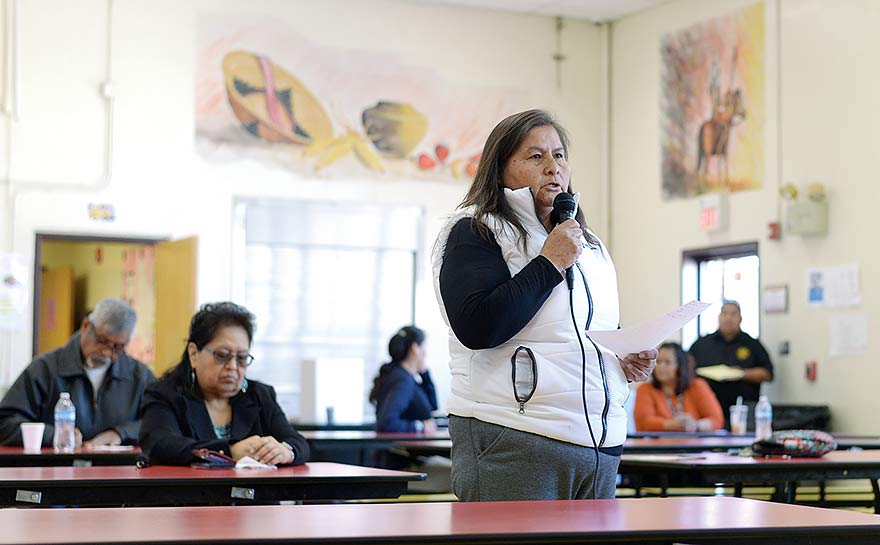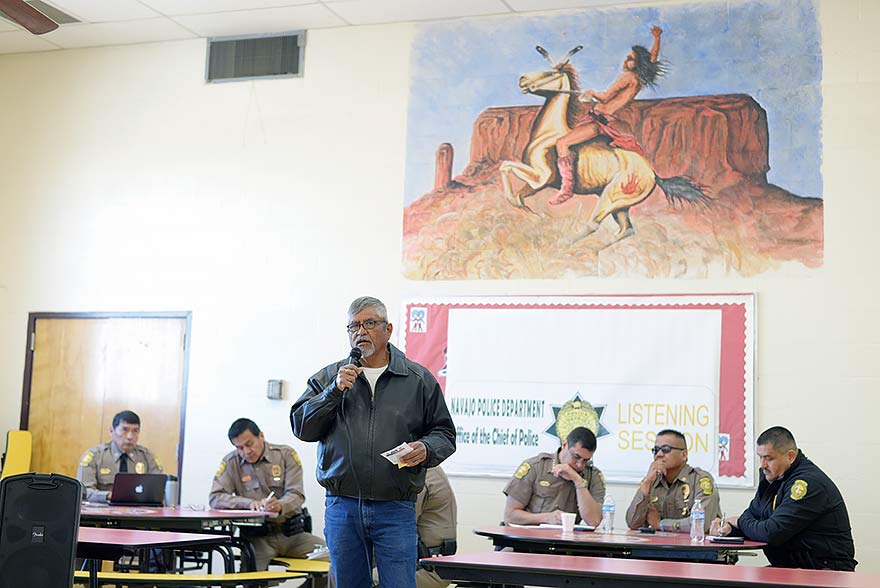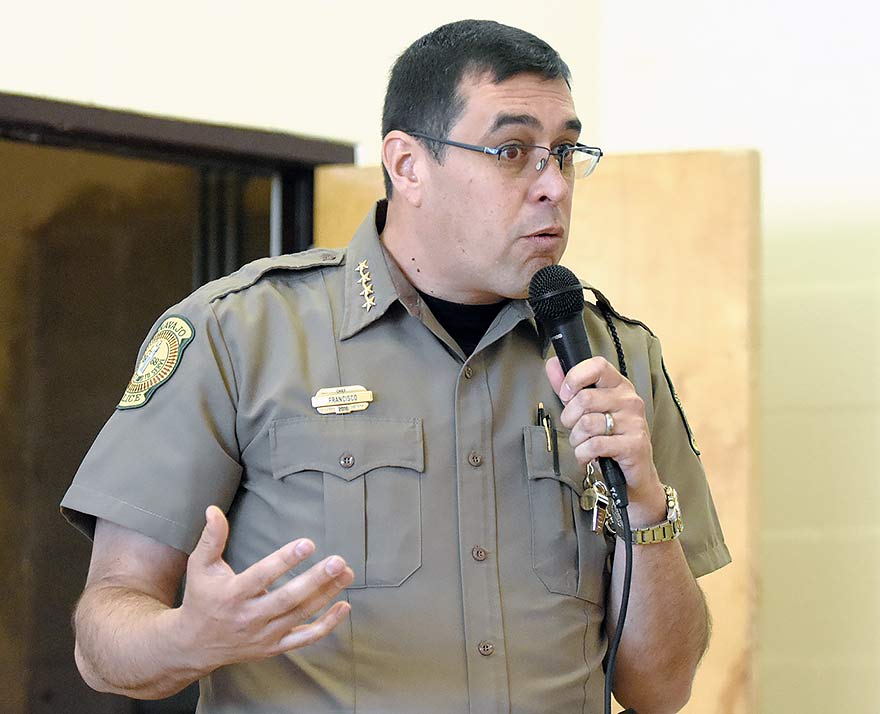
Police listening session: Eastern wants more police, quicker response times

Navajo Times | Donovan Quintero
Lifelong To’Hajiilee resident Nora Morris lists several concerns that need the police’s attention on Saturday, March 30, 2019, during a listening session in To’Hajiilee.
TO’HAJIILEE and CROWNPOINT
People say they want more police officers and quicker response times when they call for service, while police want more chapter and community involvement to help take communities back from thieves, thugs and drug dealers.

Navajo Times | Donovan Quintero
To’Hajiilee Chapter President Mark Begay speaks during a listening session on Saturday morning in To’Hajiilee.
On Saturday in To’Hajiilee, the Navajo Police began another round of listening sessions that started on Dec. 1 at Fire Rock Casino. Their mission is the same: Gather input.
The first to speak was To’Hajiilee Chapter President Mark Begay.
“I think one of our big problems is lack of police presence,” he said. “Last summer, there were some issues here and we had a community meeting and they were addressed.
“Sergeant Tommy Rogers said he was going to take these back to the lieutenant and to the captain,” he said. “But they never responded to those issues.”
Begay added that if the Navajo Nation is not up to providing police service, they should turn it over to the BIA.
“Let the BIA service us,” he said.
Nora Morris, a resident for more than 50 years, said her community held a groundbreaking and bought three trailers in 2006 and placed them near the chapter house.
“A police officer had been living in them for a while,” Morris said. “But they’re old and they’ve released them back to our community members. That’s something we had put forth. We did our part back then and we gave them brand new buildings.”
An officer’s first arrest
Capt. Henry Moore said he was the officer she was talking about.
“I was out here in the mid 2000s,” he said, and he moved into one of the trailers.
“There was lack of police service when I first arrived to To’Hajiilee,” he said. “There was only three officers, three veterans – burned out. Now imagine trying to revitalize officers that just didn’t want to do their work anymore.”
Moore said the “norm” back then when dealing with a disorderly drunk was to drive them around until they sobered up, after which the officer would take them home.
“That created the chaos here in To’Hajiilee and Alamo,” he said. “I made my first arrest. The first question that was asked of me by that person was, ‘When are you going to take me home?’ I said, ‘No, you’re disturbing at your house. You’re just disrupting family life. Why should I take you home?’”
The person he arrested that day was an elected tribal official.
“At that point, I got a letter saying, ‘You have two weeks to move out – we’re gonna move a juvenile probation officer in there,’” he recalled. “Imagine how that makes you feel, doing your job, and then you do the right thing and the community tells you to leave.”
Morris said she was once arrested by the Navajo Police and transported 130 miles to Crownpoint where the jail was located. She wondered why the tribal police had not yet built a detention center on To’Hajiilee land that was set aside for them.
“I was told, ‘You’re a free woman’ the next day. I was only held for less than a day, and they said, ‘There’s the door,’” she told Francisco and his entourage.
“I just walked out and came back with my thumb,” she said. “In today’s society, it’s crazy. I could have been picked up. I would not be standing here.”
Chief: Lack of officers
In addition to making arrests and transporting them to jail in Crownpoint, daily DUI and warrant checkpoints were conducted to catch the drunk drivers coming in from Albuquerque.

Navajo Times | Donovan Quintero
Police Chief Phillip Francisco explains the progress his department has made the last three years during a listening session on Saturday in To’Hajiilee, N.M.
At the session in Crownpoint even fewer people attended the meeting, held at the high school. Most of the questions the police answered came from their Facebook page, which they used for discussion at the community meetings.
Francisco said he wanted the department and communities to work together to begin solving the issues. The chief also indicated that patience is necessary.
“Right now with 205 officers, and it also includes the command staff here and all the administrative staff, we only have probably three or four officers on duty at a given district at any given time,” Francisco said.
“That’s about 20 officers across the Navajo Nation that are on duty to cover all the calls,” he said.
Each officer, Francisco said, responds to five or six calls a day that require them to drive to the place their services are needed.
“They’re call time is totally booked up,” he said. “So if you don’t see them in your communities, it’s because they’re actually doing their work. They’re actually out there because we don’t have enough people to do the calls that are coming in.”
Another issue Francisco said would become a problem is running out of funding once all 230 police officer positions are filled.
“Now, with the revised budget, we have positions for 230 officers,” he said. “We have almost 30 that are gonna be in the next academy class.
“Within the next year we should have all our vacant positions filled and we’ll have no more money,” he said. “With those 230 positions that means there are only 230 commissioned officers that are out there covering the 27,000 square miles of Navajo Nation in seven districts. We need probably 450 officers to really be on par.”
Currently, the ’638 contract that funds the Navajo police doesn’t have anymore funding. Francisco said his staff will make their request to the feds in 2020 using data collected by a consultant they hired in December. This nine-month project can help the department receive funding to hire more police officers.
“We need to advocate, we need communities to advocate that we need more money,” he told a handful of people who attended the listening session. “The Navajo Nation, or somebody, needs to give us more money because I will fulfill my promise of filling all the positions that I have money for.”
Active shooter drills
Two Sandoval County Fire and Rescue personnel attended the Crownpoint meeting. The fire chief, Allen Trujillo, said active shooter scenarios in school settings were becoming more frequent and asked Francisco had plans for them.
Trujillo said two weeks ago a person showed up at one of the reservation schools armed with a BB gun. At the time, he said, police did not know if the weapon was an actual firearm.
“We were listening to the scanner for some (New Mexico) State Police and for Sandoval County Sheriff’s Office,” Trujillo said. “That’s how we heard about it. We got our guys ready for whatever may come down the line if something should happen. We were trying to be prepared.”
Trujillo said four schools are located in his area – Torreon Day School, Tse Yi Gai High, Pueblo Pintado Community School and Ojo Encino Day School.
“There’s times when we have calls that come in where we need (the police department) to come clear the scene,” he said. “And it’ll be on the reservation side of our district and we have to wait for Crownpoint to respond.
“I feel like we need to do some better work as far as between Navajo PD and outside agencies such as our department in Sandoval County,” he said.
“I know school shootings and active shooter in the school system is a pretty important thing,” Francisco told Trujillo. “We have 266 schools on the reservation — a lot of schools to cover. We don’t have two officers to man all of those. We realize we really have to work with the schools to figure out a way to respond to these better.”
At the moment, with 205 officers on staff, he said response time to an emergency was anywhere between 20 minutes and an hour, which makes it more important for them to begin devising a plan with all the reservation schools.
Francisco said the department has been working with school superintendents and administrators and will hold a three-day summit. He didn’t say when the summit would take place.
“We still have a lot of work to do,” he said. “We need to make sure we get our partners in place. But as we move along, we’ll be doing more scenario-based practices. We’re gonna be more involved as we go along.”
The next listening sessions are on April 7 at the Indian Wells Elementary School in Indian Wells, Arizona, from 10 a.m. to 12 p.m., then at St. Michael Indian School from 3 p.m. to 5 p.m. On April 13, a session will be at Whitehorse High School in Montezuma Creek, Utah, from 3 p.m. to 5 p.m.
Information: 928-871-6363.
To read the full article, pick up your copy of the Navajo Times at your nearest newsstand Thursday mornings!
Are you a digital subscriber? Read the most recent three weeks of stories by logging in to your online account.








 Highway 264,
Highway 264, I-40, WB @ Winslow
I-40, WB @ Winslow